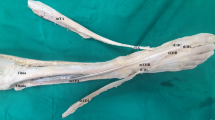Abstract
Most of the anatomic variations of the extensor hallucis longus (EHL) muscle are related to the tendon of insertion. We show a double origin of the EHL from the medial aspect of the fibula and the lateral aspect of the tibia. A 27-year-old male with a double closed fracture of tibia and fibula showed an involuntary extension of the big toe during foot plantar flexion after surgery. A tendon fibrosis by the fixation plates could be the cause of the foot functional alteration. Interestingly, the anatomic variation described could be related to the postsurgical foot dysfunction, since when the fibrotic tissue was removed the normal extension of big toe recovered. As illustrated in this case report, knowledge of anatomic variations is very useful, particularly in the context of foot surgery.


Similar content being viewed by others
References
Aktekin M, Uzmansel D, Kurtoglu Z et al (2008) Examination of the accessory tendons of extensor hallucis longus muscle in fetuses. Clin Anat 21:713–717. https://doi.org/10.1002/ca.20712
Al-saggaf S (2003) Variations in the insertion of the extensor hallucis longus muscle. Folia Morphol (Warsz) 62:147–155
Bayer T, Kolodziejski N, Flueckiger G (2014) The extensor hallucis capsularis tendon-a prospective study of its occurrence and function. Foot Ankle Surg 20:192–194. https://doi.org/10.1016/j.fas.2014.04.001
Bergman RA, Afifi AK, Miyauchi R (2010) Illustrated encyclopedia of human anatomic variation: Opus I: muscular system: alphabetical listing of muscles: E. https://www.anatomyatlases.org/AnatomicVariants/MuscularSystem/Text/E/23Extensor.shtml
Bibbo C, Arangio G, Patel DV (2004) The accessory extensor tendon of the first metatarsophalangeal joint. Foot Ankle Int 25:387–390. https://doi.org/10.1177/107110070402500604
Boyd N, Brock H, Meier A et al (2006) Extensor hallucis capsularis: frequency and identification on MRI. Foot Ankle Int 27:181–184. https://doi.org/10.1177/107110070602700305
Gruber W (1875) Über die varietäten des musculus extensor hallucis longus. Arch Anat Physiol Wissen Med 1875:565–589
Hill RV, Gerges L (2008) Unusual accessory tendon connecting the hallucal extensors. Anat Sci Int 83:298–300. https://doi.org/10.1111/j.1447-073X.2008.00229.x
Hallisy JE (1930) The muscular variations in the human foot: a quantitative study. Am J Anat 45:411–442. https://doi.org/10.1016/j.aanat.2017.10.006
Lambert HW (2016) Leg muscles. In: bergman’s comprehensive encyclopedia of human anatomic variation. Wiley, Hoboken, pp 421–437. https://doi.org/10.1002/9781118430309
Natsis K, Konstantinidis GA, Symeonidis PD et al (2017) The accessory tendon of extensor hallucis longus muscle and its correlation to hallux valgus deformity: a cadaveric study. Surg Radiol Anat 39:1343–1347. https://doi.org/10.1007/s00276-017-1881-4
Testut L, Latarjet A (1928) Traité d’anatomie humaine, vol 1. Doin, Paris, p 1149
Tezer M, Cicekcibasi AE (2012) A variation of the extensor hallucis longus muscle (accessory extensor digiti secundus muscle. Anat Sci Int 87:111–114. https://doi.org/10.1007/s12565-011-0108-8
Williams PL, Bannister LH, Berry MM et al (1995) Gray’s anatomy: the anatomical basis of medicine and surgery, 38th edn. Churchill Livingstone, Edinburgh
Zdilla MJ, Paulet JE, Lear JJ et al (2018) A review of extensor hallucis longus variants featuring a novel extensor primi internodii hallucis muscle merging with extensor hallucis brevis. J Foot Ankle Surg 57:1218–1220. https://doi.org/10.1053/j.jfas.2018.03.031
Author information
Authors and Affiliations
Corresponding author
Ethics declarations
Conflict of interest
The authors declare that they have no conflict of interest to disclose.
Additional information
Publisher's Note
Springer Nature remains neutral with regard to jurisdictional claims in published maps and institutional affiliations.
Electronic supplementary material
Below is the link to the electronic supplementary material.
276_2019_2309_MOESM1_ESM.avi
Supplementary material 1: Video 1. Testing of foot plantar flexion. Involuntary extension of the big toe during foot plantar flexion. Simultaneous plantar flexion of all toes was not possible. (AVI 2162 kb)
276_2019_2309_MOESM2_ESM.avi
Supplementary material 2: Video 2. Testing of foot plantar flexion. Following surgery (primary closure), foot plantar flexion without extension of the big toe was possible. Skin incisions and surgical staples can be observed. (AVI 518 kb)
Rights and permissions
About this article
Cite this article
Egea, J.M., Cabeza, L., Ortiz, R. et al. Double origin of the extensor hallucis longus muscle: a case report. Surg Radiol Anat 41, 1421–1423 (2019). https://doi.org/10.1007/s00276-019-02309-5
Received:
Accepted:
Published:
Issue Date:
DOI: https://doi.org/10.1007/s00276-019-02309-5




